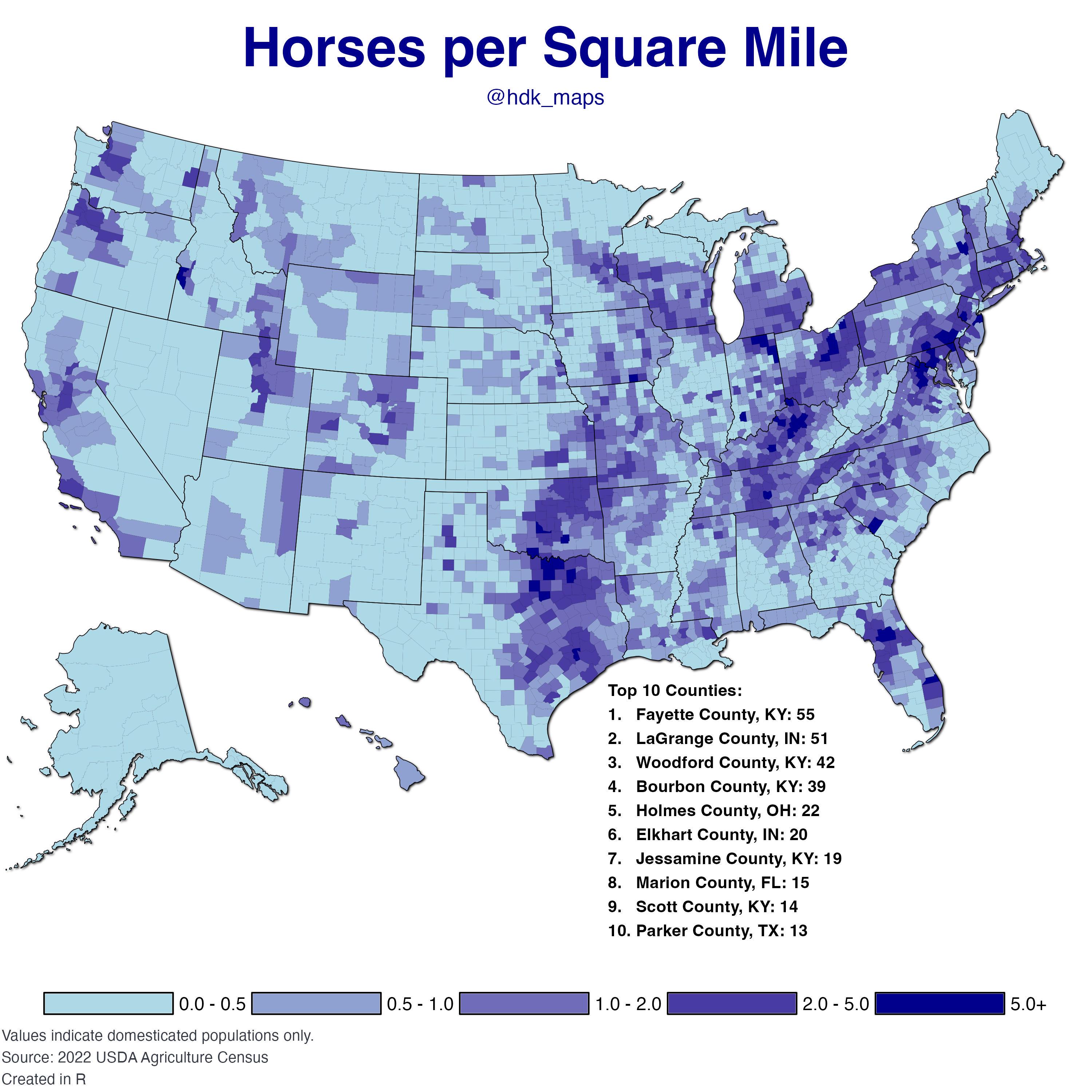Horses per Square Mile in the USA Map


David Chen
Data Visualization Specialist
David Chen is an expert in transforming complex geographic datasets into compelling visual narratives. He combines his background in computer science ...
Geographic Analysis
What This Map Shows
The "Horses per Square Mile in the USA Map" provides a fascinating visualization of the distribution of horses across the United States. By analyzing horse density, this map reveals where horses are most prevalent in relation to land area, offering insights into equestrian culture, agriculture, and the rural landscape of America. As we delve into this topic, we’ll explore the historical and cultural factors that have shaped horse populations in various regions of the country.
Deep Dive into Horses in the USA
Horses have played a pivotal role in American history, serving as companions, work animals, and symbols of freedom and adventure. From the days of Native American tribes using horses for transportation and hunting to the development of ranching and rodeo culture, these majestic animals have left an indelible mark on the American landscape.
Interestingly, the United States is home to millions of horses, with estimates suggesting around 7 million equines as of the latest data. The distribution of these horses varies dramatically by region. Factors influencing horse populations include availability of land, climate, cultural practices, and economic activities. For example, states like Texas, Oklahoma, and Kentucky boast the highest densities of horses, largely due to their strong equestrian traditions and expansive rural areas.
Texas stands out as the state with the most horses, with over 1 million horses residing within its borders. The Lone Star State's vast open spaces and ranching heritage create an ideal environment for horse breeding and training. Moreover, the annual Houston Livestock Show and Rodeo showcases the deep-rooted connection between Texans and their horses.
Kentucky, often referred to as the "Horse Capital of the World," is renowned for its thoroughbred racing industry. The state’s rolling pastures and favorable climate contribute to a high density of horses, making it a hub for breeding and training elite racehorses. Additionally, Kentucky's rich equestrian culture is celebrated through events like the Kentucky Derby, which draws international attention and showcases the significance of horses in American culture.
In contrast, regions such as the Northeast, while historically significant in equestrian activities, show lower horse densities. Urbanization and land development have led to a decrease in available open space for horse ownership. However, pockets of equestrian communities remain, particularly in areas like New Jersey and Pennsylvania, where horse shows and riding schools flourish.
Regional Analysis
Examining the map allows us to discern interesting regional patterns. The Western United States, including states like Wyoming and Montana, also displays a relatively high density of horses per square mile. These states are characterized by their vast landscapes and a lifestyle that often integrates livestock farming, ranching, and outdoor recreation, all of which contribute to a robust equestrian culture.
Conversely, states in the Midwest, such as Illinois and Indiana, show moderate horse densities. Here, horses are often kept for recreational purposes, including trail riding and local competitions. The agricultural backdrop of the Midwest offers a different relationship with horses, focusing on their utility in farming and community events rather than racing or performance.
Interestingly, the Southeastern states, while historically connected to horse culture through events like the annual Georgia National Fair and various rodeos, reveal a mixed picture. Some areas, particularly in Florida, have vibrant equestrian communities, but the overall density of horses per square mile tends to be lower compared to the West and South.
Significance and Impact
Understanding the distribution of horses across the United States is not merely an exercise in mapping; it has real-world implications for agriculture, land use, and cultural identity. The presence of horses often reflects broader trends in land management, agricultural practices, and rural economies.
As urban areas continue to expand, the implications for horse ownership and equestrian activities become increasingly significant. Many horse owners are finding it more challenging to maintain access to riding trails and stables, leading to a decline in urban equestrian activities. Additionally, as environmental concerns grow, the sustainability of horse keeping in densely populated areas is coming into question.
Looking forward, trends like the rise in interest in equine therapy and recreational riding indicate that horses will continue to hold cultural significance. Moreover, the potential impact of climate change on pasture availability and water resources could reshape the future of horse populations in certain regions.
In conclusion, the "Horses per Square Mile in the USA Map" serves as a vital tool for understanding the intricate relationship between horses and the American landscape, highlighting how geography, culture, and economics intertwine to shape the presence of these remarkable animals.
Visualization Details
- Published
- October 11, 2025
- Views
- 48
Comments
Loading comments...